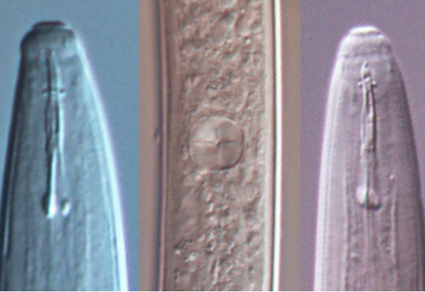Abstract
One new genus and a new species belonging to the superfamily Tylencholaimoidea from the Western Ghats, India are described and illustrated. Oostenbrinkellus gen. n. is characterized by being a medium sized nematode with a 0.92–1.3 mm long body; lip region cap-like with distinct labia disc; amphidial fovea cup-shaped, aperture occupying about two-thirds to four-fifths of the lip region diameter; odontostyle 10.5–12.0 µm long, slender, slightly sinuate, mid region bent slight dorsally, anterior beak-like, with a distinct ventral stiffening piece covering the posterior half of the ventral arm; its aperture about one-fifth of the odontostyle length, 1.6–2.0 times the lip region diameter long; odontophore 7.5–9.0 µm long, with distinct basal knobs, total stylet 18.5–20.5 µm; pharynx consisting of an anterior slender part, expanding posteriorly into a short cylindrical basal bulb, 19–25% of total pharyngeal length; female genital system mono-opisthodelphic with anterior uterine sac; tail long filiform both the sexes; males with 24–29 μm long spicules. Lawtonema indicum sp. n. is characterized by having a 1.25–1.28 mm long body; lip region cap-like with distinct labial disc; amphidial fovea cup-shaped, aperture occupying about three-fourths of the lip region diameter; odontostyle 10–10.5 μm long, its tip bent dorsally; odontophore 9.5–10 μm long, total stylet length 19.5–20.0 μm; pharynx expanding gradually into a short cylindrical bulb, 19–20% of total pharyngeal length; female genital system amphidelphic; tail long filiform; male with 24 μm long spicules.
References
- Cobb, N.A. (1918) Estimating the nema population of the soil. United States Department of Agriculture, Bureau of Plant Industry, Agriculture Technical Circular, 1, 1–48.
- Cobb, N.A. (1915) Some freshwater nematodes of the Douglas Lake region of Michigan, U.S.A. In: Cobb, M.V., Transactions of the American Microbiological Society, 34, pp. 21–47. https://doi.org/10.2307/3221598
- de Maeseneer, J. & d’Herde, J. (1963) Méthodes utilisées pour l’étude des anguillules libres du sol. Revue Agriculture, Bruxelles, 16, 441–447. https://doi.org/10.1163/187529259X00381
- Dhanachand, C., Renubala, K. & Mohilal, N. (1991) Two new species of Dorylaimida from Manipur, India. Uttar Pradesh Journal of Zoology, 1991, 81–86.
- Dhanam, M. & Jairajpuri, M.S. (1999) New leptonchid nematodes: One new genus and eleven new species from Malnad tracts of Karnataka, India. International Journal of Nematology, 9, 205–209.
- Goseco, C.G., Ferris, V.R. & Ferris, J.M. (1974) Revision in Leptonchoidea (Nematoda: Dorylaimida). Tyleptus in Leptonchidae, Tyleptinae; Basirotyleptus in Leptonchidae, Belonenchinae and Loncharionema n. gen. in Leptonchidae, Xiphinemellinae. Research Bulletin, Purdue University Agriculture Experimental Station, Purdue University, West Lafayette, 913, 1–24.
- Islam, M.N., Imran, Z. & Ahmad, W. (2019) A new species of the rare nematode genus Rostrulium Siddiqi, 1995 (Nematoda: Dorylaimida: Tylencholaimidae) from India. Zootaxa, 4550 (4), 573–578. https://doi.org/10.11646/zootaxa.4550.4.7
- Jairajpuri, M.S. (1964) Dorella mira n. gen., n. sp. (Nematoda: Dorylaimoidea) from India. Proceedings of the Helminthological Society of Washington, 31, 222–224.
- Jairajpuri, M.S. (1965) Oostenbrinkella oostenbrinki n. gen., n. sp. (Nematoda: Leptonchidae) from the soil around the roots of the jack tree. Proceedings of the Helminthological Society of Washington, 32, 122–124.
- Okada, H., Harada, H., Tsukiboshi, T. & Araki, M. (2005) Characteristics of Tylencholaimus parvus (Nematoda: Dorylaimida) as a fungivorus nematode. Nematology, 7, 843–849. https://doi.org/10.1163/156854105776186424
- Peña Santiago, R., Peralta, M. & Siddiqi, M.R. (1993) Taxonomy of some new and known species of the genus Tylencholaimellus with a proposal for Margollus gen. n. (Nematoda: Dorylaimida). Nematologica, 39, 218–233. https://doi.org/10.1163/187529293X00178
- Seinhorst, J.W. (1959) A rapid method for the transfer of nematodes from fixative to anhydrous glycerin. Nematologica, 15, 81–100. https://doi.org/10.1163/187529259X00381
- Siddiqi, M.R. (1995) Nematodes of tropical rainforests.5. Seven new genera and forty two new species of dorylaims. Afro-Asian Journal of Nematology, 5, 72–109.
- Siddiqi, M.R. (1998) Lawtonama lawtoni gen. n, sp. n. and four new species of Discomyctus (Dorylaimida: Tylecholaimidae) from tropical rainforests. International Journal of Nematology, 8, 131–140.
- Thorne, G. & Swanger, H.H. (1936) A monograph of the nematode genera Dorylaimus Dujardin, Aporcelaimus n. g., Dorylaimoides n. g., and Pungentus n. g. Capita Zoologica, 6, 1–223.


